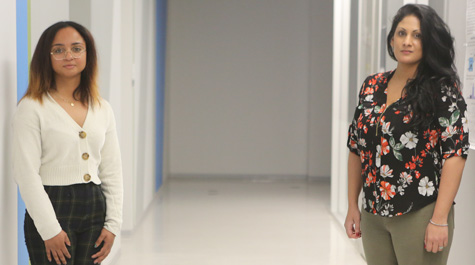2 Applied Science doctoral students awarded SREB doctoral scholars fellowships
Two Ph.D. students in William & Mary’s Department of Applied Science are recipients of Doctoral Scholars Program Fellowships of the Southern Regional Education Board (SREB), a program aimed at increasing diversity among college and university STEM faculty.
Tina Naik is a state doctoral scholar, a recipient of a three-year fellowship. First-year Ph.D. student Jordan Hines was accepted as an institute scholar in the SREB program.
Naik, who was instrumental in securing William & Mary’s membership in SERB, explains the difference between state scholars and institutional doctoral scholars. First of all, the application process is not the same, nor are the benefits. Hines’ graduate study will be funded through a partnership of the commonwealth and the university. Naik’s funding comes wholly from one source.
“As a state scholar, I am supported by the state,” she said. “That means they support three to five years of my whole Ph.D. — tuition, stipend and everything.”
A member of Christopher Del Negro’s mammalian respiratory neurobiology lab, Naik studies the genesis of breathing. Working with animal models, she is investigating the ionic mechanisms for inspiratory rhythmogenesis, specifically the role of a persistent sodium current engendered by a voltage-gated sodium channel.
“We genetically silence the sodium channels and subsequently measure ventilatory parameters to characterize the role of a persistent sodium current in respiratory rhythmogenesis,” Naik explained.
It’s research that requires a great deal of time in the lab, she added, recording breathing through various stages of development.
Hines is cycling through three labs, standard for a first-year Ph.D. student. She is working with Del Negro’s lab, with Greg Conradi Smith’s computational biology lab and in Margaret Saha’s lab.
“And so I'm potentially going to work on a joint project with the three labs,” Hines said. “However, right now, I am working on a research project with an undergraduate student in Dr. Saha’s phage lab.”
Lianne Ashburne, the graduate program coordinator in applied science, said the department is proud to have pioneered the program at William & Mary.
“We’re aiming to increase diversity in the department,” Ashburne said. “Tina helped to initiate this process, and we’re happy that Jordan came in and we could have two SREB scholars back-to-back.”
The SREB website states that more than a third of U.S. college students are people of color, but that racial and ethnic minorities continue to make up only a small fraction of faculties in higher education: 5 percent are African American, 3 percent are Hispanic and about 1 percent are Native American. SREB was founded in 1948 as the first interstate compact for education.
Gov. Ralph Northam is Virginia’s lead representative to the board of SREB, which encompasses 16 states. Financial support, including funds for the Doctoral Scholars Program, comes from the member states, supplemented by private foundations and grants. Its mission is to improve the academic success of all minority groups at levels from kindergarten up to people like Naik, who is preparing to receive her Ph.D.
Naik says that she found SREB’s programming for doctoral scholars to be quite helpful, particularly its Institute on Teaching and Mentoring. She said she is grateful for the honor and especially for the financial support, which has given her a degree of independence as she continues her research.
“It’s liberating,” she said. “It allows me to make more of my own scientific decisions. I hope that Jordan and other scientists of color can benefit from it as well.”
 Skip to main content
Skip to main content

